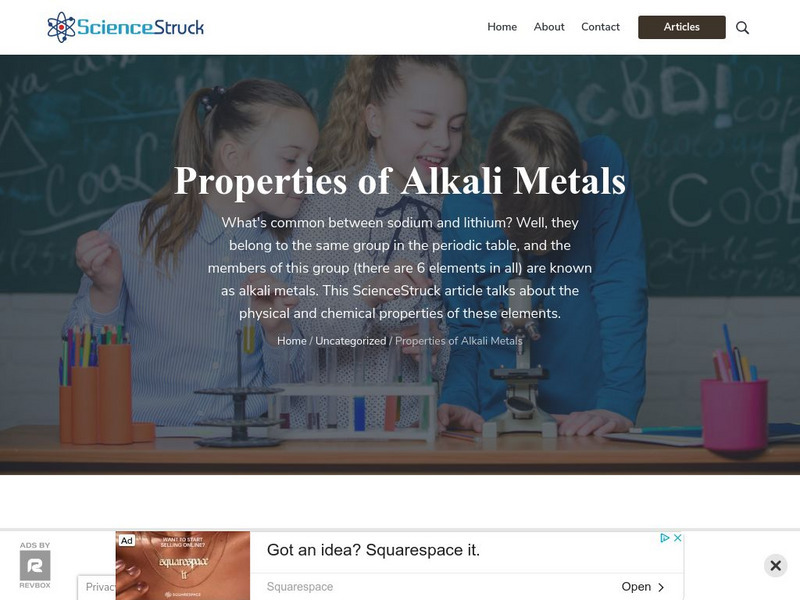Science Struck
Science Struck: Industrial and Medicinal Uses of Sulfur
Read about the properties of sulfur, how it is produced, and its many uses in industry and medicine.
Science Struck
Science Struck: The Story Behind Who Discovered Sulfur and When
Learn about the discovery of sulfur, where it is found, some of its properties, and some interesting facts about it.
Science Struck
Science Struck: Properties of Alkali Metals
Describes the physical and chemical properties of the six alkali metals.
Science Struck
Science Struck: Uses of Alkali Metals
Lists the properties of the alkali metal group of the periodic table and describes each of the six elements and their uses.
Science Struck
Science Struck: A Guide to Projectile Motion With Real Life Examples
Projectile motion is explained here. Includes a discussion of Newton's Second Law of Motion, the formulas used to make different calculations, real-life examples of projectile motion at work, and sample problems with solutions.
Science Struck
Science Struck: A Comprehensive Printable List of Geometry Formulas
Provides a list of area and perimeter formulas for two-dimensional shapes and volume and surface area formulas for three-dimensional solids.
Science Struck
Science Struck: Metric System Chart for Kids
This resource explains the structure of the metric system of measurement; the basic units of measurement for length, volume, and mass; and provides charts for each type of measurement. A chart of customary US units is also given.
Science Struck
Science Struck: Dry Ice vs. Liquid Nitrogen Explore the Differences
Explains the differences between dry ice and liquid nitrogen, what each is used for, and safety recommendations.
Science Struck
Science Struck: Emission Spectrum vs. Absorption Spectrum
Explains the difference between an emission spectrum and an absorption spectrum, and describes each as well as their applications.
Science Struck
Science Struck: Working of an Infrared Thermometer
Learn how an infrared thermometer works and what each of its parts does. A chart lists the different applications of infrared thermometers by the wavelength each emits.
Science Struck
Science Struck: Radioactive Isotopes in Medicine
Learn what radioactive isotopes are and the different ways that they are used in medicine.
Science Struck
Science Struck: Isotopes of Carbon
Describes the characteristics of carbon and what an isotope is. Presents a chart of carbon isotopes listing nuclide symbol, atomic weight, half-life, and nuclear spin, as well as a second chart listing radioactive carbon isotopes....
Science Struck
Science Struck: Advantages and Disadvantages of Nuclear Energy
Discusses the pros and cons of nuclear energy.
Science Struck
Science Struck: Bromine Isotopes
Describes the chemical properties of bromine and what an isotope is. Presents a chart of bromine isotopes listing nuclide symbol, neutron number, isotopic mass, and half-life, as well as a second simpler chart with more bromine isotopes.
Science Struck
Science Struck: Facts About Thomas Edison
Read about the life of Thomas Edison and his many inventions.
Science Struck
Science Struck: The Accomplishments of Isaac Newton
Read about the life of Isaac Newton and his many accomplishments in physics, mathematics, optics, and religious study, and how his discoveries helped in space research.
Science Struck
Science Struck: The Structure of an Atom: A Labeled Diagram
Looks at the scientists who developed the model of the atom by building on previous scientists' discoveries about its structure.
Science Struck
Science Struck: The Calibration Curve
Explains what Beer's Law and a spectrophotometer have to do with calibration curves. Describes the steps in making a calibration curve, by first making a set of standard solutions, then using a spectrophotometer to find the absorbance of...
Science Struck
Science Struck: Grassland Biome: Animals and Plants
Describes the characteristics, biodiversity, and the adaptations of the plants and animals of temperate and tropical grasslands.
Science Struck
Science Struck: Taiga Biome: Taiga Animals and Plants
Describes the characteristics of the taiga biome and the plants and animals that live there.
Science Struck
Science Struck: Facts About the Marine Biome
Describes the characteristics of the marine biome, the plants and animals that live in each of the four ocean zones, coral reefs and estuaries, the climate of the marine biome, and the marine food web.
Science Struck
Science Struck: Ldpe Plastic
LDPE stands for low-density polyethylene. This resource describes its structure, physical and chemical properties, resistance to various chemicals, advantages and disadvantages, uses, its BPA-free status, and the issue of recycling LDPE...
Science Struck
Science Struck: Biography of Albert Einstein
The life and many accomplishments of Albert Einstein are detailed in this article. Includes descriptions of his scientific theories and contributions.
Science Struck
Science Struck: A List of California State Symbols
Presents images and descriptions of each of the many state symbols of California.



